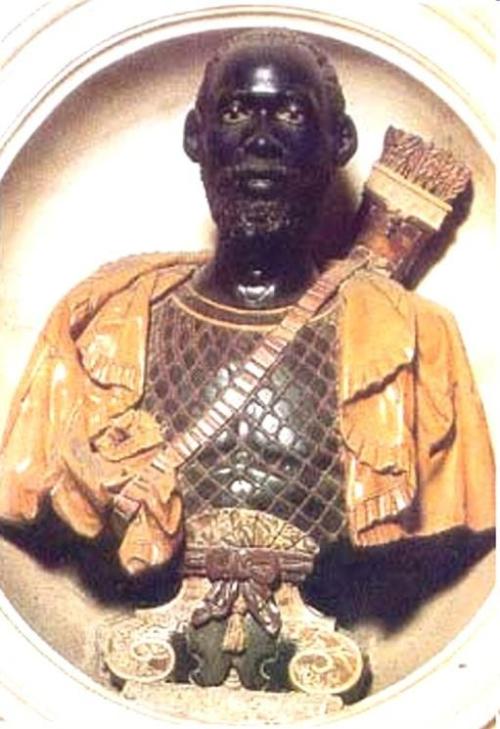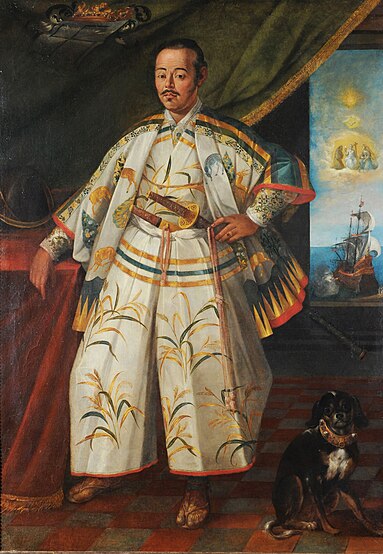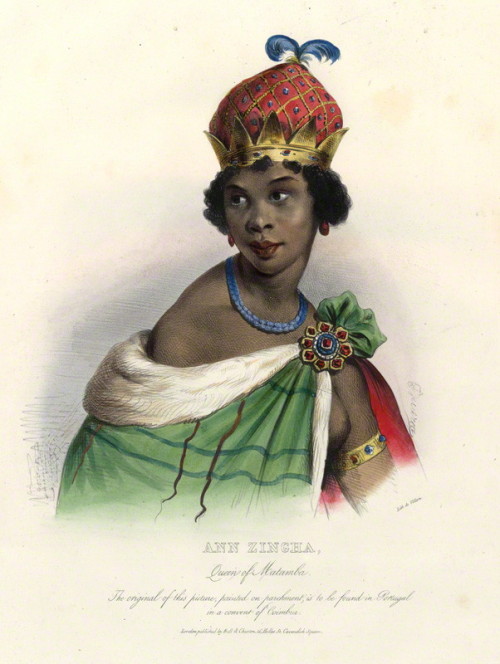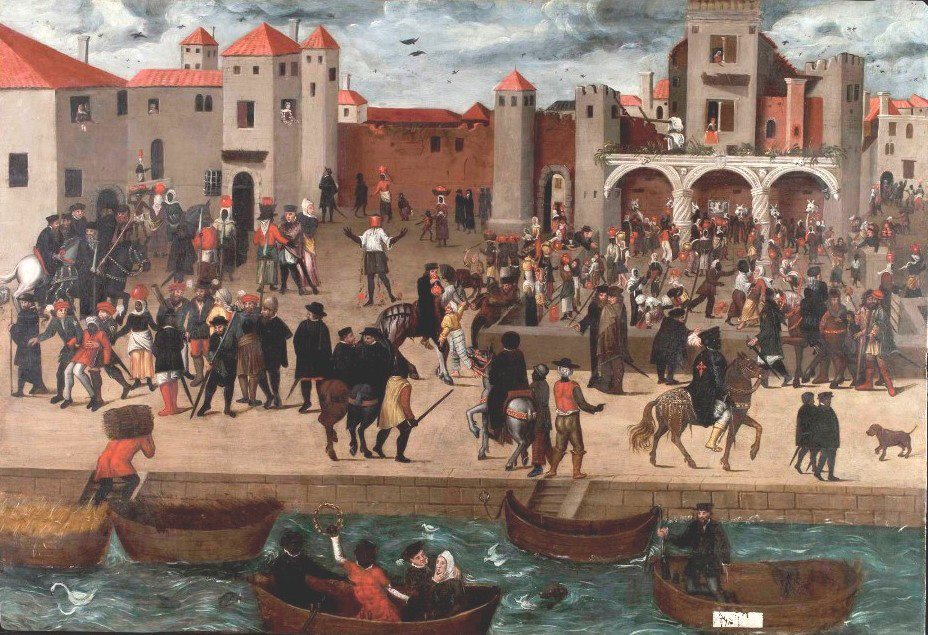Post by anansi on Jan 21, 2013 4:18:46 GMT -5
I have posted a Video concerning the monster King Leopold II
egyptsearchreloaded.proboards.com/index.cgi?board=pav&action=display&thread=1378
destructive role in making the Kongo a heart of so-called darkness,and earlier yet had made a post about King Afonso. egyptsearchreloaded.proboards.com/index.cgi?board=hist&action=display&thread=1008
This post is about the Kingdom and it's developement as a whole drawn from various sources.
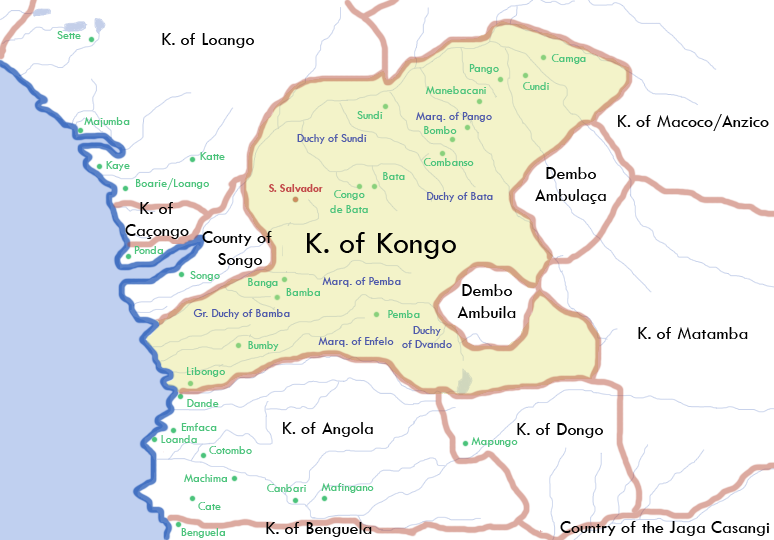
![]()

llustration of the ruler of Loango, from Dapper's Description of Africa (1668)
Earliest human settlement, in what is now the DRC, stretches back some 10 000 years. The earliest settlers were in all likelihood short statured hunter-gathers, now known (though controversially so) as pygmies. Some 1 300 years ago these Stone Age peoples were followed by Bantu and Nilotic speaking hunter-gatherer groups, who settled initially in the northern savannah areas. In time the new-comers adopted or developed the cultivation of tropical crops, cattle husbandry and iron working technology which enabled them to subdue and displace the original pygmy populations, gradually driving them into the mountains and the thicker parts of the rain forest.
In the Congo area a number of extensive and complex trading states emerged in the savannah; the Kongo kingdom, the Luba Empire, the Lunda kingdom, the Zande kingdoms, and the kingdom of Kuba. While chiefdoms did emerge within the rainforests, they never rivaled the savannah states for size and complexity.
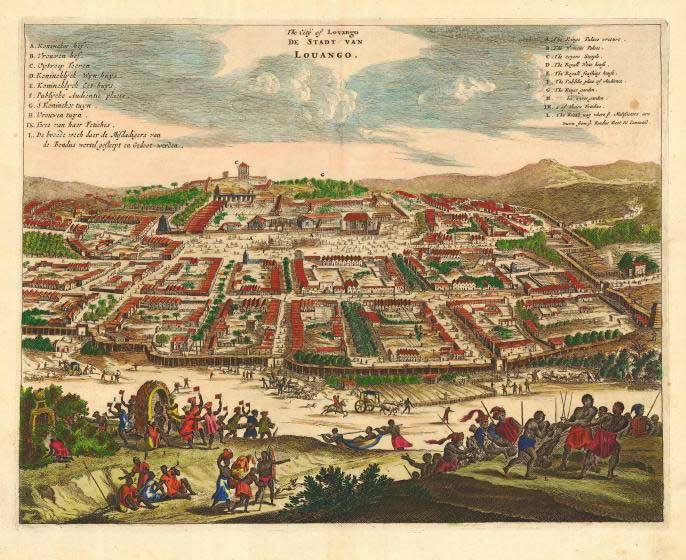
The Kingdom of Kongo (1400– 1914)
The first of these, the Kongo kingdom, was founded by invaders from the north east who settled south of the Congo River in the late 1300s and grew to encompass the north of modern Angola and the western areas of the DRC (Library of Congress 1993)
Foundation of the Kingdom
The first king of the Kingdom of Kongo Dya Ntotila was Lukeni lua Nimi (circa 1280-1320).The name Nimi a Lukeni appeared in later oral traditions and some modern historians, notably Jean Cuvelier, popularized it. Lukeni lua Nimi or Nimi a Lukeni, became the founder of Kongo when he conquered the kingdom of the Mwene Kabunga (or Mwene Mpangala), which lay upon a mountain to his south. He transferred his rule to this mountain, the Mongo dia Kongo or "mountain of Kongo", and made Mbanza Kongo, the town there, his capital. Two centuries later the Mwene Kabunga's descendants still symbolically challenged the conquest in an annual celebration. The rulers that followed Lukeni all claimed some form of relation to his kanda or lineage and were known as the Kilukeni. The Kilukeni kanda or "house" as recorded in Portuguese documents would rule Kongo unopposed until 1567.
After the death of Nimi a Lukeni, his brother, Mbokani Mavinga, took over the throne and ruled until approximately 1367. He had two wives and nine children. His rule saw an expansion of the Kingdom of Kongo to include the neighbouring state of Loango and other areas now encompassed by the current Republic of Congo.
The Mwene Kongos often gave the governorships to members of their family or its clients. As this centralization increased, the allied provinces gradually lost influence until their powers were only symbolic, manifested in Mbata, once a co-kingdom, but by 1620 simply known by the title "Grandfather of the King of Kongo" (Nkaka'ndi a Mwene Kongo).
The high concentration of population around Mbanza Kongo and its outskirts played a critical role in the centralization of Kongo. The capital was a densely settled area in an otherwise sparsely populated region where rural population densities probably did not exceed 5 persons per square kilometer. Early Portuguese travelers described Mbanza Kongo as a large city, the size of the Portuguese town of Évora as it was in 1491. By the end of the sixteenth century, Kongo's population was probably close to half a million people in a core region of some 130,000 square kilometers. By the early seventeenth century the city and its hinterland had a population of around 100,000, or one out of every five inhabitants in the Kingdom (according to baptismal statistics compiled by Jesuit priests). This concentration allowed resources, soldiers and surplus foodstuffs to be readily available at the request of the king. This made the king overwhelmingly powerful and caused the kingdom to become highly centralized.
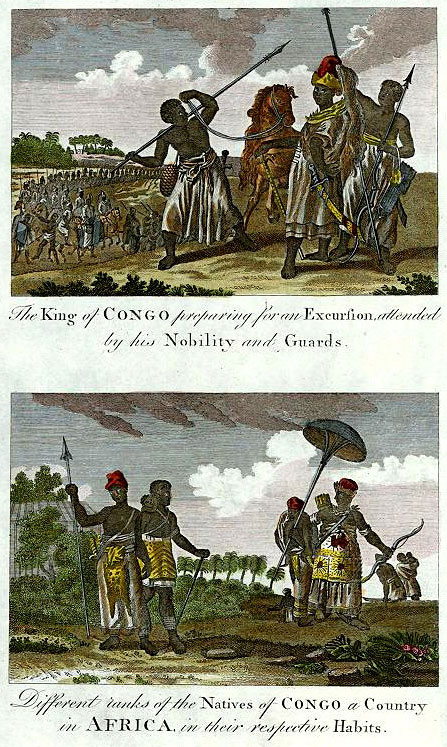

.jpg)
By the time of the first recorded contact with the Europeans, the Kingdom of Kongo was a highly developed state at the center of an extensive trading network. Apart from natural resources and ivory, the country manufactured and traded copperware, ferrous metal goods, raffia cloth, and pottery. The Kongo people spoke in the Kikongo language. The eastern regions, especially that part known as the Seven Kingdoms of Kongo dia Nlaza (or in Kikongo Mumbwadi or "the Seven"), were particularly famous for the production of cloth.
The Luba state coalesced some 100 years after the Kongo and to the east of it, in the upper reaches of the Lualaba River, around lakes Upemba and Kisale. The Lunda kingdom emerged 15th century through the unification of its composite chiefdoms in the south west on the patterns laid down by their Luba neighbours. In the sixteenth century its territory was overrun by the expanding Luba empire, and, unable to resist the invaders, some of the Lunda migrated to Angola where they founded new states.
The kingdom of Kuba was founded to the north of the Kasai River, and of its tributary the Sankura, by invaders from the west in about 1600. The complex forest-river-savannah ecology of its territory enabled it to develop into a vigorous trading state that was able to maintain its integrity until it fell to the advance of Belgian colonial expansion (Giblin 1999)
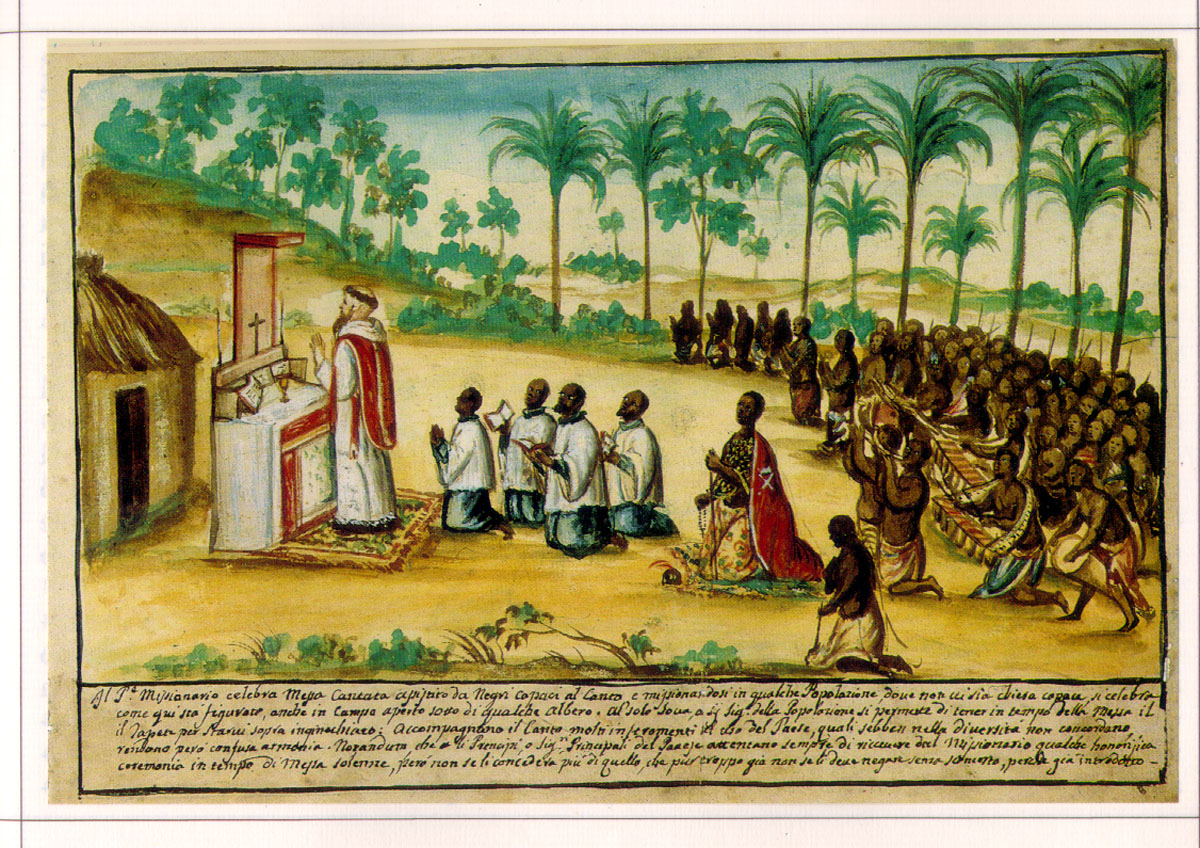
Capuchin Missionary Celebrating Mass, Sogno, Kingdom of Kongo.
In the late fifteenth century Portuguese explorers established contact with the Kongo kingdom, and traders and missionaries followed on their heels. Initial friendly relations between the Kongo and the Portuguese soured as a result of Portuguese rapacity and especially their insatiable demand for slaves. In later years the expansion of the Portuguese coastal enclaves brought control over land as a new focus of conflict (Library of Congress 1989, 1993, Columbia Encyclopedia 2001).

Catholic Priest Burning Idol House, Sogno, Kingdom of Kongo.
In the early 1600s, weakened by conflicts with the Portuguese and other neighbours, internal struggles for power and the ravages of the slave trade, the kingdom progressively disintegrated. Over time it lost control over its constituent parts and the trade routes that had been the source of its wealth and power. By 1700 the kingdom was a spent force (Library of Congress 1993).
The Lunda experienced a resurgence of their fortunes with the establishment of the Zembe kingdom in Katanga and northern Zambia in about 1740. The state's wealth and expansion was fueled by trade in slaves and ivory with the Portuguese on the coast. In the mid-nineteenth century the kingdom came close to collapse as it fended off penetration by Swahili slave traders from the east. The kingdom was saved by cooperation with the British South African Company, only to be partitioned between the Belgians and the British (Gordon 2004).
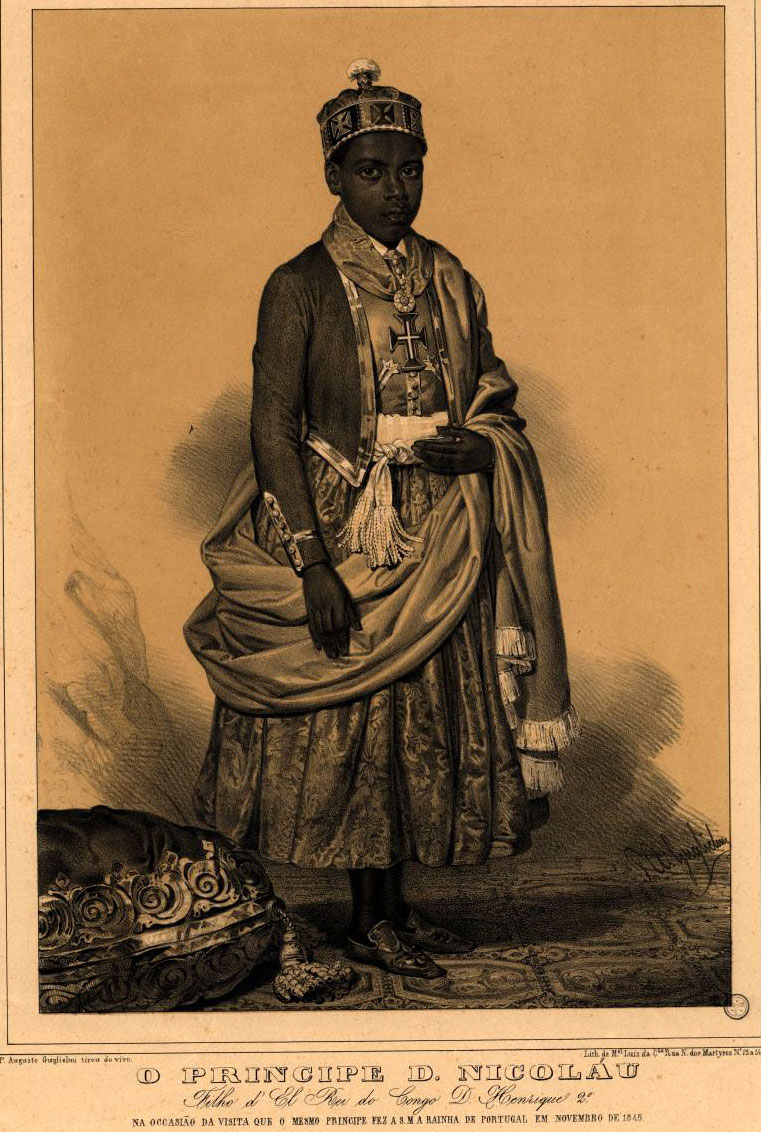
The Luba kingdom, in the meanwhile, had become increasingly unstable and was wracked by internal dynastic struggles. Its expansion was checked by the rise of Lunda polities to the south and west, the Kuba kingdom to the north. The weakened state was not able to resist the penetration of slave traders from east Africa and the state disintegrated in the late nineteenth century.
www.africafederation.net/Kongo_History.htm
wysinger.homestead.com/loango.html
egyptsearchreloaded.proboards.com/index.cgi?board=pav&action=display&thread=1378
destructive role in making the Kongo a heart of so-called darkness,and earlier yet had made a post about King Afonso. egyptsearchreloaded.proboards.com/index.cgi?board=hist&action=display&thread=1008
This post is about the Kingdom and it's developement as a whole drawn from various sources.


llustration of the ruler of Loango, from Dapper's Description of Africa (1668)
Earliest human settlement, in what is now the DRC, stretches back some 10 000 years. The earliest settlers were in all likelihood short statured hunter-gathers, now known (though controversially so) as pygmies. Some 1 300 years ago these Stone Age peoples were followed by Bantu and Nilotic speaking hunter-gatherer groups, who settled initially in the northern savannah areas. In time the new-comers adopted or developed the cultivation of tropical crops, cattle husbandry and iron working technology which enabled them to subdue and displace the original pygmy populations, gradually driving them into the mountains and the thicker parts of the rain forest.
In the Congo area a number of extensive and complex trading states emerged in the savannah; the Kongo kingdom, the Luba Empire, the Lunda kingdom, the Zande kingdoms, and the kingdom of Kuba. While chiefdoms did emerge within the rainforests, they never rivaled the savannah states for size and complexity.

The Kingdom of Kongo (1400– 1914)
The first of these, the Kongo kingdom, was founded by invaders from the north east who settled south of the Congo River in the late 1300s and grew to encompass the north of modern Angola and the western areas of the DRC (Library of Congress 1993)
Foundation of the Kingdom
The first king of the Kingdom of Kongo Dya Ntotila was Lukeni lua Nimi (circa 1280-1320).The name Nimi a Lukeni appeared in later oral traditions and some modern historians, notably Jean Cuvelier, popularized it. Lukeni lua Nimi or Nimi a Lukeni, became the founder of Kongo when he conquered the kingdom of the Mwene Kabunga (or Mwene Mpangala), which lay upon a mountain to his south. He transferred his rule to this mountain, the Mongo dia Kongo or "mountain of Kongo", and made Mbanza Kongo, the town there, his capital. Two centuries later the Mwene Kabunga's descendants still symbolically challenged the conquest in an annual celebration. The rulers that followed Lukeni all claimed some form of relation to his kanda or lineage and were known as the Kilukeni. The Kilukeni kanda or "house" as recorded in Portuguese documents would rule Kongo unopposed until 1567.
After the death of Nimi a Lukeni, his brother, Mbokani Mavinga, took over the throne and ruled until approximately 1367. He had two wives and nine children. His rule saw an expansion of the Kingdom of Kongo to include the neighbouring state of Loango and other areas now encompassed by the current Republic of Congo.
The Mwene Kongos often gave the governorships to members of their family or its clients. As this centralization increased, the allied provinces gradually lost influence until their powers were only symbolic, manifested in Mbata, once a co-kingdom, but by 1620 simply known by the title "Grandfather of the King of Kongo" (Nkaka'ndi a Mwene Kongo).
The high concentration of population around Mbanza Kongo and its outskirts played a critical role in the centralization of Kongo. The capital was a densely settled area in an otherwise sparsely populated region where rural population densities probably did not exceed 5 persons per square kilometer. Early Portuguese travelers described Mbanza Kongo as a large city, the size of the Portuguese town of Évora as it was in 1491. By the end of the sixteenth century, Kongo's population was probably close to half a million people in a core region of some 130,000 square kilometers. By the early seventeenth century the city and its hinterland had a population of around 100,000, or one out of every five inhabitants in the Kingdom (according to baptismal statistics compiled by Jesuit priests). This concentration allowed resources, soldiers and surplus foodstuffs to be readily available at the request of the king. This made the king overwhelmingly powerful and caused the kingdom to become highly centralized.


.jpg)
By the time of the first recorded contact with the Europeans, the Kingdom of Kongo was a highly developed state at the center of an extensive trading network. Apart from natural resources and ivory, the country manufactured and traded copperware, ferrous metal goods, raffia cloth, and pottery. The Kongo people spoke in the Kikongo language. The eastern regions, especially that part known as the Seven Kingdoms of Kongo dia Nlaza (or in Kikongo Mumbwadi or "the Seven"), were particularly famous for the production of cloth.
The Luba state coalesced some 100 years after the Kongo and to the east of it, in the upper reaches of the Lualaba River, around lakes Upemba and Kisale. The Lunda kingdom emerged 15th century through the unification of its composite chiefdoms in the south west on the patterns laid down by their Luba neighbours. In the sixteenth century its territory was overrun by the expanding Luba empire, and, unable to resist the invaders, some of the Lunda migrated to Angola where they founded new states.
The kingdom of Kuba was founded to the north of the Kasai River, and of its tributary the Sankura, by invaders from the west in about 1600. The complex forest-river-savannah ecology of its territory enabled it to develop into a vigorous trading state that was able to maintain its integrity until it fell to the advance of Belgian colonial expansion (Giblin 1999)

Capuchin Missionary Celebrating Mass, Sogno, Kingdom of Kongo.
In the late fifteenth century Portuguese explorers established contact with the Kongo kingdom, and traders and missionaries followed on their heels. Initial friendly relations between the Kongo and the Portuguese soured as a result of Portuguese rapacity and especially their insatiable demand for slaves. In later years the expansion of the Portuguese coastal enclaves brought control over land as a new focus of conflict (Library of Congress 1989, 1993, Columbia Encyclopedia 2001).
Catholic Priest Burning Idol House, Sogno, Kingdom of Kongo.
In the early 1600s, weakened by conflicts with the Portuguese and other neighbours, internal struggles for power and the ravages of the slave trade, the kingdom progressively disintegrated. Over time it lost control over its constituent parts and the trade routes that had been the source of its wealth and power. By 1700 the kingdom was a spent force (Library of Congress 1993).
The Lunda experienced a resurgence of their fortunes with the establishment of the Zembe kingdom in Katanga and northern Zambia in about 1740. The state's wealth and expansion was fueled by trade in slaves and ivory with the Portuguese on the coast. In the mid-nineteenth century the kingdom came close to collapse as it fended off penetration by Swahili slave traders from the east. The kingdom was saved by cooperation with the British South African Company, only to be partitioned between the Belgians and the British (Gordon 2004).

The Luba kingdom, in the meanwhile, had become increasingly unstable and was wracked by internal dynastic struggles. Its expansion was checked by the rise of Lunda polities to the south and west, the Kuba kingdom to the north. The weakened state was not able to resist the penetration of slave traders from east Africa and the state disintegrated in the late nineteenth century.
www.africafederation.net/Kongo_History.htm
wysinger.homestead.com/loango.html



